- Register
- Log in to Tune-In
- Wishlist (0)
-
Shopping cart
(0)
You have no items in your shopping cart.
Beatles News

Humans are strange and complicated creatures, so it makes sense that when you put four ultra-creative, super-talented, ridiculously imaginative musicians in a room together, there's bound to be some conflict. In the case of The Beatles, there ended up being a lot of conflict — and that means that even though it's Yoko Ono who frequently gets blamed for their honestly inevitable breakup, that's not actually the case. Not entirely, at least.
What happened was more along the lines of a perfect storm of trials and tribulations that the band just couldn't weather — starting with the death of their longtime manager and massive disagreements over who was going to replace him. Add in more disagreements over their direction, individual members who wanted to nurture their individual talents, arguments over who was going to get their songs on albums, stress from rampant drug use, and yes, the added pressures of Yoko Ono's appearances on the scene and in the studio, and something just had to give.
Source: DB Kelly/grunge.com
details
Paul McCartney had a clear vision for 'Hey Jude.' When he pushed back on George Harrison's contributions, Harrison grew irritated.
George Harrison and Paul McCartney were the first members of The Beatles to meet. They grew close in their adolescence and would go on to become founding members of one of the biggest bands in the world. Their time in the band was not beneficial to their relationship, though. Harrison and McCartney bickered often about music. McCartney recalled the struggle they faced while working on “Hey Jude” when Harrison made it clear he didn’t like the direction McCartney was taking the song.
By the late 1960s, Harrison felt McCartney was overly domineering. When McCartney gave Harrison instructions, their interactions often devolved into arguments.
“If I made a suggestion and it was something that, say, George didn’t want to do, it could develop quite quickly into a mini-argument,” McCartney said in The Beatles Anthology. “In fact, George walked out of the group. I’m not sure of the exact reason, but I think that they thought I was being too domineering.”
This happened while they were recording “Hey Jude.” McCart details

George Harrison let another rock star use the guitar Eric Clapton played on The Beatles' "While My Guitar Gently Weeps." The star used it on a tune from Apple Records.
George Harrison let another rock star use the guitar that Eric Clapton played on The Beatles’ “While My Guitar Gently Weeps.” What an honor! That rock star used the guitar on another classic song. “While My Guitar Gently Weeps” is a beloved tune but it was never a hit in the United States.
Peter Frampton is a rock star who was part of the bands The Herd and Humble Pie. He also had a number of solo hits, including “Do You Feel Like We Do,” “Baby, I Love Your Way,” “Show Me the Way,” and “I’m in You.” In a 2022 Loudersound interview, Frampton recalled what it was like getting to work with George and company. “It was: ‘Nice to meet you, man … Do you want to play?’ I said: ‘You mean now?’
“They’d just finished writing this song for Doris Troy, called ‘Ain’t That Cute,'” he recalled. “So he gave me ‘Lucy,’ that red Les Paul that he used on a lot of later records, and the one Eri details

As 1968 came to a close, the Beatles were for the first time in a state of creative limbo. In late November of that year, they’d released The Beatles, their sprawling double-disc effort popularly known as the White Album. The record showed an impressive creative breadth, yet it revealed the band’s lack of focus with its assortment of disparate songs, many of which were recorded without the participation of the full band.
While the White Album was an unqualified success at retail, critics were sharply divided in their estimation of it. Nowhere was this more evident than in the New York Times, where it was deemed a “major success” by one reviewer and “boring beyond belief” by another.
The start of a new year is a traditional opportunity to take stock of one’s circumstances and begin anew. Certainly, that’s what the Beatles had in mind when, on January 2, 1969, they convened for the first time since the White Album sessions to begin work on a new project titled 'Get Back.' Dreamed up and orchestrated by Paul McCartney, the effort was designed to get the foursome back on track, working together as a single entity and recording live in the studio details
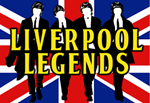
‘If any journalist asks you about the Beatles because you’re from Liverpool, say you hate them and you don’t listen to that old crap.’ Such was the advice that the DJ Roger Eagle, promoter and founder of the legendary (and there really is no other word for it) Merseyside punk club Eric’s, dispensed to a young Ian Broudie in the late 1970s. Little could either have imagined that almost simultaneously John Lennon, over in New York in the Dakota Building, was busy demo-ing ‘Now and Then’. It was a song which would resurface as the final Beatles single and top the charts some 40-odd years later, aided by a form of AI technology that possibly only members of Dalek I, the Wirral’s wackier answer to Kraftwerk, could have dreamt of back then.
Source: Travis Elborough/spectator.co.uk
details
Wings recorded “Live and Let Die” during sessions for Red Rose Speedway, but this, one of their defining songs, was made for another project and wasn’t included on the album. Paul McCartney wrote the song for the 1973 James Bond film of the same name. And there was controversy over who would sing it.
He’d struggled early in his post-Beatles career, fighting depression and writer’s block in the aftermath of leaving the biggest band in the world. He had a foil in John Lennon and an identity as a “Beatle,” but the new decade found him at war with critics’ anti-McCartney bias.
McCartney’s early home studio recordings have aged well, but contemporary critics weren’t pleased. After recording Ram with his wife, Linda, in 1971, McCartney formed a new band called Wings. Inspired by Bob Dylan’s breakneck recording pace, they recorded their debut quickly, and U.K. critics viewed Wild Life as rushed and overhyped. Now, the man who wrote “Yesterday” needed a hit.
Source: Thom Donovan/americansongwriter.com
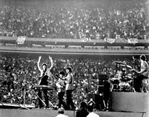
John Lennon began putting on a comical show during a Beatles concert. Ringo Starr thought he had gone 'mad.'
In 1965, John Lennon, Paul McCartney, George Harrison, and Ringo Starr played a show at New York’s Shea Stadium. The concert was The Beatles’ largest to date and, understandably, jangled their nerves. While they said they always felt better once they got onstage, Starr noticed some surprising behavior in Lennon. He believed Lennon went “mad” during the show.
The Beatles’ concert at Shea Stadium had over 55,000 attendees, making it their largest concert up to that point. They found it overwhelming and, according to Starr, the pressure got to at least one of them.
“If you look at the film footage you can see how we reacted to the place,” Starr said in The Beatles Anthology. “It was very big and very strange. I feel that on that show John cracked up. He went mad; not mentally ill, but he just got crazy. He was playing the piano with his elbows and it was really strange.”
According to Lennon, he was doing a Jerry Lee Lewis impression and using his feet to play the piano.
“I was putting my foot on it and George couldn’t p details

Following hard on the heels of Père Duval – who, the previous night, had a sedate audience singing popular religious songs – Les Beatles made their entry to Paris on Thursday at the Olympia music-hall. “There are too many hairdressers invited to Parisian galas these days for such badly combed people to have a triumph,” sniffed the critic of Le Figaro. But he did appreciate what he described as “an exhibition of English boxe staged in the wings by a gros commando of journalists direct from Fleet Street.”
The audience for the premiere were for the most part highly varnished members of tout-Paris nightclub and entertainment life. Ringo Beatle complained gloomily that the house was full of old people and not much heat could be expected to be generated. He spoke just a moment too soon.
They had suddenly appeared in our midst, fringed eyes and teeth gleaming, like a clutch that had strayed from Duck Soup. It was not until they had slid into their dressing room that the photographers decided they wan details

George Harrison's "My Sweet Lord" has quite the pedigree. While "My Sweet Lord" was famous in the United States, its success in the United Kingdom is jaw-dropping.
George worked with a superstar producer and another rock star to record the track. While “My Sweet Lord” was famous in the United States, its success in the United Kingdom is jaw-dropping.
Peter Frampton revealed why he helped George Harrison record ‘My Sweet Lord’
During a 2022 interview with Loudersound, Peter Frampton revealed he became friends with George after meeting the “Give Me Love (Give Me Peace on Earth)” singer at Trident Studios. “George called a few weeks later and said: ‘Pete, I’m doing my own album with Phil Spector. Would you come and play some acoustic? Phil wants, like, nineteen of everything,'” Frampton recalled. The album in question was George’s magnum opus, All Things Must Pass.
Source:Matthew Trzcinski/cheatsheet.com
details
In 1950, a young George Martin, having been educated at the acclaimed Guildhall School of Music and Drama, joined the British record label EMI as a producer. Five years later he became the head of Parlophone Records where he specialized in classical and comedy recordings. Martin, however, was always on the lookout for ways to expand the label’s scope, so he began considering musical acts that he would have previously passed over.
His life would be forever altered in 1962 when four young lads from Liverpool (calling themselves “The Beatles”) walked in looking to make a recording. Martin was initially skeptical about the group’s potential. At that point, they were a young and relatively unknown band, but they had built a reputation as an entertaining live act, so Martin agreed to an audition.
In their initial session, Martin was struck by the member’s personalities and their witty banter, but he wasn’t immediately convinced of their musical prowess. He also had heard that the group had been turned down by most of the other major record labels, making Parlophone one of their last chances.
Source: mountaintimes.info
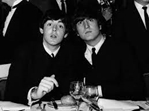
Paul McCartney and John Lennon wrote many of The Beatles' songs together. McCartney shared that he had little to do with 1 early hit.
When The Beatles released “Please Please Me” in early 1963, both Paul McCartney and John Lennon received writing credit. The pair wanted to be the next Rodgers and Hammerstein, and they established the precedent of earning joint credit for their songs. According to McCartney, though, he didn’t have all that much to do with writing the song. He admitted that “Please Please Me” was more of Lennon’s song than his own.
After achieving success with “Love Me Do,” The Beatles exploded with the release of “Please Please Me.” It was a song McCartney and Lennon worked on together, but McCartney admitted that it was more of Lennon’s song than his.
“We’d had a fair bit of practice writing over the years, though our legendary ‘first one hundred’ was probably in reality less than half that amount of songs,” McCartney said in The Beatles Anthology. “‘Please Please Me’ was more John than me; I didn’t have such a hand in it.”
Source: Emma McKee/cheatsheet.co details

Beatle George Harrison was pigeon-holed as the "Quiet Beatle," but the youngest member of the Fab Four had an acerbic, dry sense of humor that was as sharp as the rest of his bandmates.
He gave great performances in the musical comedy classics, "A Hard Days Night" and "Help!" while holding his own during The Beatles' notoriously anarchic press conferences. After he left the band in 1970, in addition to his musical career, he would produce the 1979 Monty Python classic, "The Life of Brian."
Harrison clearly didn't lose his sense of humor for the rest of his life. Shortly before his death in 2001, he played an elaborate prank on Phil Collins that shows how the "Here Comes the Sun" singer would go the extra mile for a laugh.In 1970, Harrison was recording his first solo record and arguably the best by a Beatle, "All things Must Pass." The session for the song, "The Art of Dying" featured former Beatle Ringo Starr on drums, keyboard legend Billy Preston on keys, virtuoso Eric Clapton on guitar, and was produced by the notorious Phil Spector.
Source: Tod Perry/upworthy.com
details
On the 10th of November 2023, ‘Now and Then’ by the Beatles topped the UK singles chart. It was written in the late 1970’s by John Lennon, worked on by George Harrison, Paul McCartney and Ringo Starr in 1995, and finally completed by Paul McCartney and Ringo Starr in 2023. Overcoming the barriers of time and space, Now and Then is the Beatles’ final act. Sixty-three years after they were founded, the Beatles have played together for the last time.
Since its release, ‘Now and Then’ has received “universal acclaim” from critics. It has also achieved the record for the longest gap between an artist’s consecutive singles reaching number one, and the longest gap between an artist’s first and last number one single. While extraordinary, this has not ‘cemented the Beatles legacy’ or ‘proved the Beatles’ enduring relevance’. Their incontestable legendary status has long been established: the best-selling band of all time, the first British band to break America, the most covered music group ever, inventors of the music video, inventors of the “conceptual album” - the list is seemingly endless.
Source: Raphael Mort details
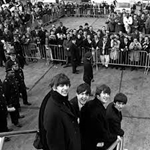
January 14, 1964, London
I was ready to head to Kenya in the morning. Then the phone rang. It was my boss, Frank Spooner, the picture editor of the Daily Express. “I’m taking you off the Africa assignment,” he said. “We’d like you to go to Paris. The Beatles are on tour there.”
My heart sank. Yes, I’d heard of the Beatles. They were getting bigger—hit song after hit song. But, at 31, I considered myself a serious journalist. As a staff photographer for London’s leading daily paper, I’d covered the rise of the Berlin Wall and broken stories in Egypt, Northern Rhodesia, and Russia. I was more interested in Kenya’s new government than in following around some rock-and-roll group.
“Frank, I’m supposed to go to Africa tomorrow,” I told him. “I’ve had all my shots.” Spooner heard me out and rang off. And I thought, Great, I dodged a bullet. At the Express, I’d built my reputation on hard news. And no place was more cutthroat than London’s Fleet Street, where staff photographers like me fought for scoops, tooth and nail, against guys on rival papers. I knew that once they put you on a music story, y details
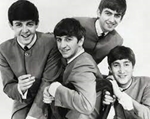
Of all the rock bands that could have launched comebacks in 2023, The Beatles were certainly the least likely. The group has been officially disbanded for half a century, and the two remaining members have not stated that they intended to get the old outfit back together to make more music. That makes sense, as half of the original members are no longer with us.
For these reasons–and so many others–nobody expected The Beatles to return with new music in 2023. And yet, somehow they did what no one thought they could and released their first original piece of work in years, “Now and Then.” In doing so, the band landed another big hit while simultaneously changing what’s possible in the music industry and dominating the music conversation once again.
In mid-2203, Paul McCartney spoke to the BBC and revealed that he was hard at work on a new Beatles track. The masses all around the world immediately freaked out–both because the most successful band of all time was gearing up to release new music, and because of the technology that was helping them do so.
Source: Hugh McIntyre/forbes.com
